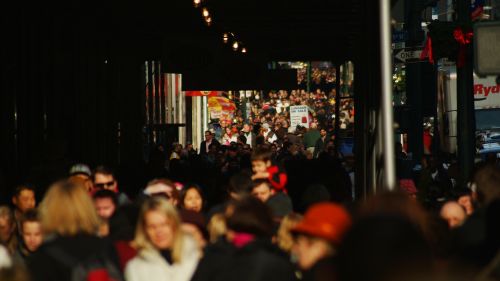Cities, Suburbs, and Immigration: Connected Economies, Divided Politics

Cities may face some challenges with neighbors in the suburbs while trying to establish policies supporting immigration.
While cities are being heralded as an “antidote” to the economically precarious hardline immigration policies likely to come out of President-elect Trump’s administration, they may face resistance in implementing pro-immigration policies from their closest neighbors: the suburbs.
The rift is a problem. Healthy immigration is a critical part of the open and integrated economic model that has allowed cities and their metropolitan areas to thrive in an increasingly globalized world.
How to bridge the gap? Cities should leverage their greater metropolitan regions to stand united in being welcoming and inclusive.
Divided Politics
Places such as Chicago have much at stake in extending warm welcomes to immigrants and refugees. More than any other major US city, Chicago depends on newcomers to offset rapid declines in its US-born population. Immigrant-owned businesses along 26th Street in Little Village generate some $900 million in revenues annually. It’s no wonder that Mayor Rahm Emanuel recently reaffirmed the city’s “sanctuary” status, adding the Windy City to a growing list of cities—Los Angeles, New York, Denver, and Philadelphia among them—redoubling their efforts around immigrant inclusion and integration.
For historic immigrant gateway cities, this posture is second nature. Yet immigration is a newer—and often more painful—phenomenon in suburbs unaccustomed to managing demographic change. Though immigration to the United States, both authorized and unauthorized, has held nearly constant since the mid-2000s, those immigrants are increasingly settling in suburbs. The foreign-born population in many of Chicago’s collar counties, for example, has mushroomed by more than 200 percent since 1990.
What does the seemingly sudden appearance of diverse newcomers in a previously homogenous community mean for electoral politics in the long-term? It’s hard to say. We do know that high rates of demographic change correlate with support for political movements that are—at least in part—associated with nationalist and anti-immigration platforms. The trend holds true on both sides of the Atlantic: in the United States, it manifested as vote for Trump; in the United Kingdom, backing of Brexit.
Results from the 2016 Chicago Council Survey clearly highlight an urban-suburban divide on attitudes toward immigration in the United States. Nationwide, outer-ring suburban residents are 12 percentage points more likely than those in a city center to say that large numbers of immigrants and refugees coming into the United States represent a critical threat. They are 15 percentage points more likely to support deportation and reject a path to citizenship. They are 20 percentage points less likely to support the United States accepting Syrian refugees and 9 percentage points more likely to call for reductions in legal immigration.
Since 2008, Chicago’s middle-ring suburbs have become moderately more likely to back Democratic, generally pro-immigration, candidates. Yet suburban support for Democratic candidates falls well below levels seen in Chicago proper, by margins of 20 percent or more. The 2016 election returns show Democratic presidential nominee Hillary Clinton’s commanding 53-point victory in urban Cook County falling to single digits in Chicago’s collar counties. Trump won by 8 percentage points in McHenry County.
Connected Economies
Immigrants and refugees have become scapegoats for global economic woes, but the reality is that newcomers offer economic and demographic vibrancy wherever they settle. Across the country, increasing diversity correlates with lower unemployment and higher wages. Immigrants are twice as likely to start businesses as their native-born counterparts, providing jobs for US-born workers in urban business districts and suburban main streets alike.
Urban immigrant gateways have long embraced the foreign-born as economic contributors rather than rejecting them as cultural threats. And now, these cities have a responsibility to—and a self-interest in—working with immigration skeptics in their neighboring suburbs to change not just hearts and minds but also policy and practice. Chicago’s sanctuary city status holds little weight if workers in neighboring Waukegan, fearing deportation after routine traffic stops, can’t commute to their jobs elsewhere in the region. Metro Chicago’s Fortune 500 corporations—including top regional employers like Boeing, Walgreens, and Allstate—will be challenged in recruiting global talent if suburban schools and neighborhoods are seen as unwelcoming to their families.
Vibrant regional economies depend on the open flow of workers and employers of all stripes across municipal borders, from the city center to the suburbs.
Regional Solutions
While metropolitan areas may be economically integrated, they are highly fractured politically and administratively, spanning dozens of local governments. Maximizing the regional economic returns of immigration requires regional integration efforts. And active cooperation on a metropolitan scale needs advocates. The leaders of major cities are well-positioned to act as conveners of this type of effort.
In Chicago, there is an able infrastructure for this work with the Metropolitan Mayor’s Caucus, a group of 270 mayors who proactively collaborate on various issues, including diversity. For at least a decade, the group has studied immigrant integration, cataloged best practices throughout the region, and convened regular conversations around addressing common challenges. The group understands that integration is not just about helping isolated communities simply cope with new immigrant influxes; instead, it is about helping regions thrive by proactively harnessing the economic dynamism and energy of new immigrant arrivals for the benefit of all residents, new and long-standing alike.
If suburbs across America feel left behind by globalization or threatened by demographic change, cities must turn outward, not inward, and work to detoxify immigration as a political flashpoint for their suburban counterparts. Chicago’s Caucus model provides a blueprint for other cities seeking to adopt a regional approach for advancing the hard work of immigrant integration. Major cities and smaller surrounding communities can share best practices around community integration, dialogue, and bridge-building. They can engage in job-training and transportation collaborations with the focus of connecting immigrant workers and employers, wherever they might be in a metropolitan region.
Big city mayors should be looking for every opportunity to bring their suburban partners into the fold. In an increasingly connected and mobile world, regional prosperity demands that regions collectively embrace and harness the economic benefits of globalization, immigration included.

